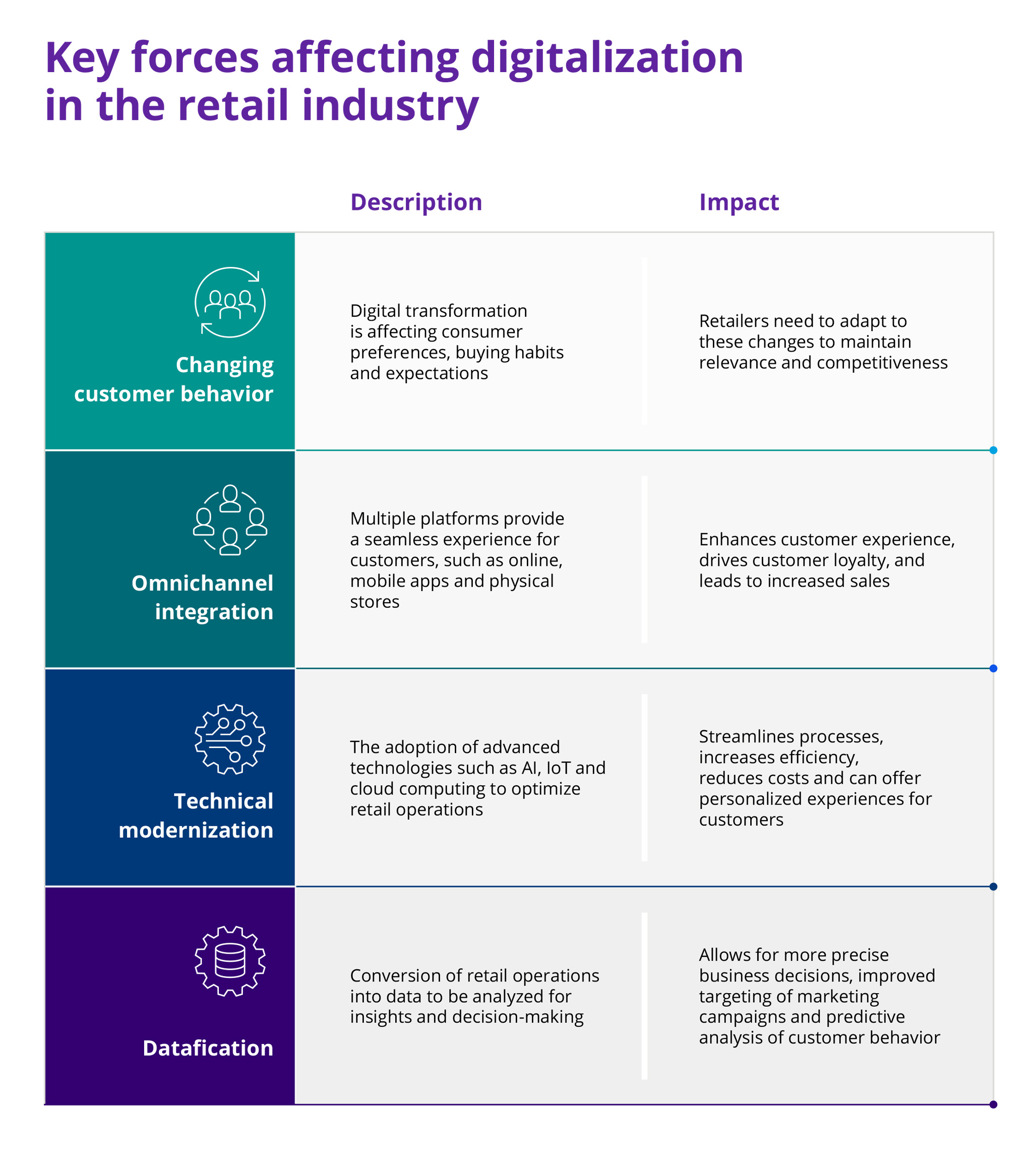In brief
- Digital shift in retail: With over 50% of 2023's consumer spending projected online, retailers are adopting digital tools like AI-powered recommendations and contactless ordering to stay competitive
- Challenges vs. benefits: In-store retailers grapple with online competition and changing consumer habits. However, digital transformation enhances in-store experiences, boosts foot traffic and optimizes operations
- Omnichannel approach: This strategy offers a seamless shopping experience across all channels. Despite integration challenges, its benefits include improved customer loyalty, increased sales and valuable data insights
For decades, selling to shoppers in a brick-and-mortar building was the one and only way. While this has continued to be fruitful for a handful of global organizations, for a majority of retailers selling in-store is no longer enough.
Fortunately, retail businesses have been able to evolve their tactics to not only survive in these online days, but also to thrive. One of the top ways for retail companies to improve customer loyalty, strengthen their brand, enhance the overall customer experience, and increase revenue is through the use of retail digital transformation.
What is retail digital transformation?
Digital transformation is how organizations utilize digital technologies and tools to revolutionize how they do business. Whether for their staff, systems or data, digital transformation is all about finding the most efficient ways to increase value and remain competitive in a constantly changing landscape. Digital transformation is especially important in one of the most highly evolving industries across the globe: Retail.
Retail digital transformation is the infusion of technology within the retail industry to enhance the overall customer experience, improve operational efficiencies and fuel growth. Digital transformation in retail might include self-checkout systems, curbside pickup, contactless ordering, AI-powered product recommendations and cost optimization technologies.
What’s driving the demand for retail digital transformation?
There are a variety of factors driving the demand for digital transformation within the retail industry, namely the use of mobile devices and applications, the need for a personalized customer experience, the growth of technologies like AI and augmented reality, and the use of data for analytics and marketing, to name a few. But with any positive driving factors there are bound to be challenges.
Challenges of in-store retail digital transformation
In-store retail is a traditional model that has been around for centuries. However, the rise of e-commerce, digital technologies, and mobile applications has led to an increase in competition and new challenges for in-store retailers. Some of these challenges include:
- Competition from online retailers
- Changing consumer behavior
- Rising costs
Competition from online retailers
Online retailers have disrupted the traditional retail model by offering lower prices, wider product selections and the convenience of online shopping. Most online retailers are able to keep a majority of products in-stock and readily available for purchase, and they are typically able to save a lot of money in the process, with lower overhead costs and fees.
In-store retailers need to find ways to differentiate themselves and provide unique value propositions to compete effectively, encouraging shoppers to come to the store while offering a valuable shopping experience.
Changing consumer behavior
Another challenge for in-store retailers is changing consumer behavior. Consumers are increasingly using digital channels to research and purchase products, and they expect a seamless and personalized shopping experience across all channels, including in-store.
A recent study from RIS News found that 57% of U.S. shoppers used their smartphone in-store to compare costs, search for coupons, or check prices through the retailer’s website or mobile app. It is crucial for in-store retailers to integrate digital technologies into their business not just to stay competitive, but to stay relevant.
Rising costs
A final major challenge for in-store retailers is budget constraints and rising costs. Not only is digitally transforming a retail company an expensive process, but also on top of all of that retailers must also consider increasing rent, inventory management and labor costs. By the time these major components are paid for, funds may not be available to enable a digital transformation, especially for small- and medium-sized retailers.
In-store retailers must be prepared to make an investment in their digital transformation strategy process and technologies, knowing that it will increase revenue in the long run.
Benefits of digital transformation in retail
Despite these challenges, digital transformation can bring numerous benefits to in-store retailers. By leveraging digital technologies, retailers can:
- Enhance the in-store experience
- Increase foot traffic
- Improve data and insights
- Optimize operations
Enhance the in-store experience
One of the biggest challenges that in-store retailers face is getting people out of their homes and into the store. Customers continue to report that they are looking for a complete experience when they shop in-store, whether through entertainment, streamlined customer service, or other offerings only available in the physical building.
Digital technologies such as mobile apps, digital signage and interactive displays can enhance the in-store experience and provide customers with personalized recommendations and promotions that they might not receive through an online platform.
Increased foot traffic
Digital marketing channels such as email, social media and mobile can help retailers reach customers in new ways and drive foot traffic to physical stores. According to a recent study released by Publicis Sapient and Salesforce, 87% of retail shoppers conduct online research into a product before they decide to buy it.
87% of retail shoppers conduct online research before buying. The overwhelming majority of retail consumers start their journey with online research.
-“Shopper-First Retailing” report.
Improve data and insights
Through the use of digital technologies, in-store retailers can gather more customer data and insights, allowing them to further personalize the shopping experience and better target customers.
Analytics from the data can help retailers to better understand their customers’ behaviors, increasing purchase rates of existing customers and targeting high-value customers for the future. These insights can also help companies better understand their customers in general, which is crucial in creating personalized and highly targeted ad campaigns that will speak directly to their wants and needs.
Optimize operations
With the data from digital marketing campaigns and in-store interactions, retailers can optimize their overall operations, enhance their inventory management, and improve supply chain efficiency. By streamlining and automating inventory processes, order fulfillment, and warehouse management, the functioning of the business will be smoother and more effective. These processes will take the burden off staff and free up valuable time for them to complete more high-level tasks.
Optimized operations will also improve the customer experience, providing a quick turnaround on orders, offering them accurate lead times, and updating them in real-time of out-of-stock items to avoid disappointment later.

What if there was a way to fuse together the benefits of in-store retail digital transformation while eliminating most of the challenges? Luckily, in 2023, there is: Omnichannel.
What is omnichannel retail?
Omnichannel retail is a strategy that involves connecting transactions between the business and the customer through a variety of different digital channels, such as in-store, online and mobile. Omnichannel helps to create a seamless shopping experience for the customer, who might be looking at a product on the retailer’s website, seeing the item is in-stock in the brick-and-mortar store, and then receiving coupons via email.
Challenges of omnichannel retail
However, omnichannel retail also presents numerous challenges, including:
- Integration of systems and processes: Omnichannel retail requires the integration of systems and processes across all channels, which can be complex and challenging
- Coordination between teams: Omnichannel retail requires coordination and collaboration between marketing, IT and operations teams to ensure a seamless and integrated shopping experience
- High investment costs: Omnichannel retail requires significant investment in technology and infrastructure, which can be costly for retailers
Although there are challenges, the benefits far outweigh them.
Benefits of omnichannel retail
With the rise in expectations surrounding the modern customer experience, including 24/7 customer service and personalized communication, it’s easy to understand the large volume of benefits that omnichannel retail might encompass. Some of these include:
- Improved customer experience
- Increased sales
- Improved data and insights
Improved customer experience
Omnichannel retail provides customers with a seamless and personalized shopping experience across all channels, increasing customer satisfaction and loyalty. Businesses can no longer settle with just having a physical location and no digital presence, or a website without solid customer support. Retailers have to continuously evolve in order to stay competitive, and the customer experience is going to play a big part in their success.

Increased sales
Retailers can increase sales and drive customer engagement by providing customers with a seamless and integrated shopping experience. With a better shopping experience, customers are more likely to stay loyal to a business and increase their lifetime value. This enhanced level of customer service can quickly set retailers apart from the competition, ensuring they come back.
Improved data and insights
Finally, omnichannel retail allows retailers to gather more customer data and insights, enabling them to understand customer behavior and preferences better. This data can be circled back through marketing, helping to create targeted campaigns that feel personalized to customers’ wants and needs. This continues to feed into the improved customer experience cycle, reiterating to the customer why they should remain loyal to the retailer.
Omnichannel digital marketing solving
in-store retail challenges
Modern retail consumers expect a seamless shopping experience, being able to easily transition from researching a product on a mobile device to picking it up in-store. It is crucial that retailers embrace omnichannel marketing to assist in their digital transformation processes, allowing customers to go from one channel to the other without any friction.
With a solid omnichannel strategy, in-store retailers can stay competitive with online sellers, provide a personalized and streamlined experience for customers with strong customer service, and can combat rising costs. By aligning with what their customers really want, retailers can obtain loyalty and drive value for years to come.
Interested in learning more?
Considering an omnichannel marketing strategy is no longer optional; it’s mission critical. Zoreza Global is a leader in digital marketing technologies and retail software development. They can create, migrate and modernize all components of retail and e-commerce technology platforms to enable a complete omnichannel experience.
If you are ready to learn more about how Zoreza Global can enhance your omnichannel marketing, connect with our team of experts today.
For further insights into the future of retail and the importance of a frictionless, personalized, and cohesive customer experience, you can read the article The future of retail banking: frictionless, personalized, cohesive.







